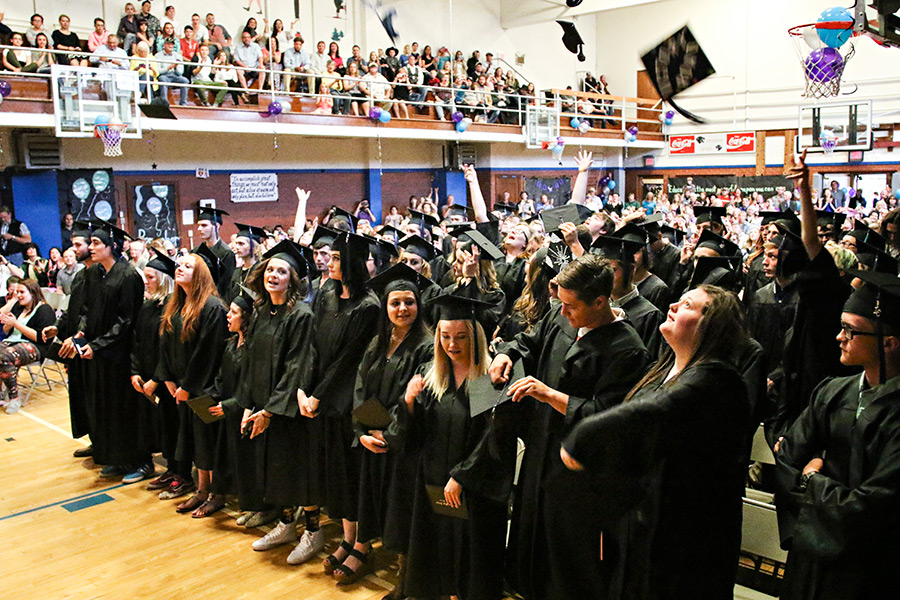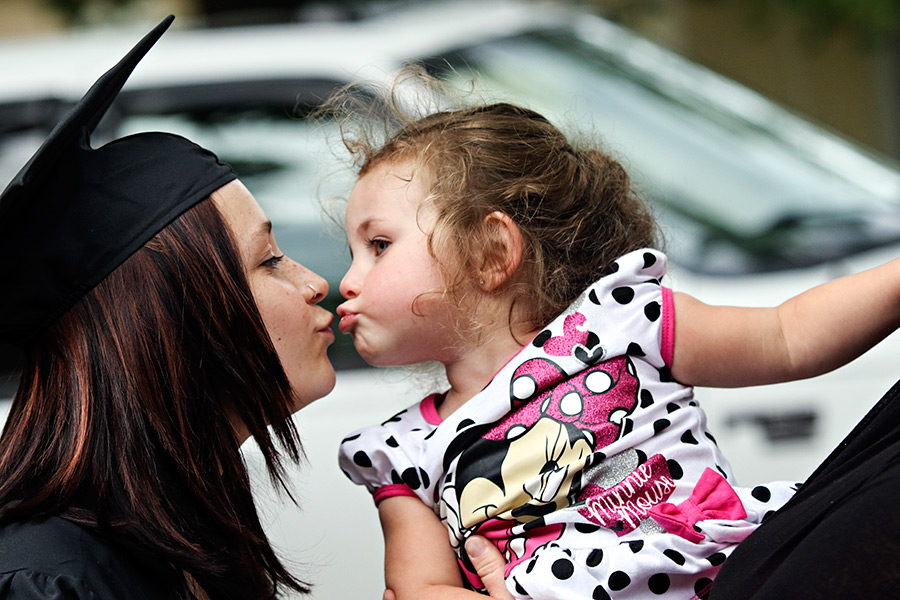When she was 15 years old, Arisa O’Lexey got pregnant. Hoping to move out of her parents’ house to find a better environment to raise her newborn baby, O’Lexey dropped out of high school and began working 40 hours a week at a pizza delivery business in Kalispell.
“I needed the money and I needed to save up as much as I could,” she says.
“I relied on myself. I didn’t have much support. It was pretty much me.”
By 17, O’Lexey was emancipated from her parents, renting a small house and raising her daughter, Lillyandra, when she became pregnant with a second child.
It was around this time O’Lexey decided she wanted a change for herself and her two young children. She was tired of working for minimal wages at a job she didn’t like, struggling to get by.
“I needed a better job so I could support the kids; just trying to give them a better life than I got, a better chance, I guess,” she says.
The best way to begin improving her situation, she decided, was to graduate high school. Yet the traditional school setting didn’t appeal to O’Lexey nor did it fit with her hectic schedule working and raising her kids.
That’s when she discovered Linderman Education Center, the alternative high school in downtown Kalispell.
O’Lexey met with Linderman’s director, Jodie Barber, and shared her situation and goals, her dream of following a new path. Barber explained the flexibility of the classes and schoolwork while also laying down the guidelines that every student must follow to achieve their diploma, including passing at least 20 credits, or 40 classes. At Linderman, students have the same set of required courses and standards as other high schools, but they can complete their studies in whichever order they want at their own pace, with half-day or night sessions available.
This setup seemed like it could work for O’Lexey, so she gave it a try despite doubts from many people around her.
Last week O’Lexey walked in front of over 500 people inside the gym at Linderman wearing a cap and gown and accepted her high school diploma. Her two children, Lillyandra and Bowen, were there along with family and friends who attended to celebrate the milestone. Upon graduating, O’Lexey has a job as a certified nursing assistant.
“It’s been super hard, but now I’m graduating. It’s crazy,” she says. “I feel like it’s a dream.”

Last week 83 young men and women graduated from Linderman Education Center. Each of them had a story as unique as O’Lexey’s, yet each shared a common bond, tied to this year’s class motto: You are the author of your own life story. You can start a new chapter anytime you choose.
In this year’s group of graduates, as always, some came from broken homes, raised by single parents or extended family. Some were former drug users expelled from other schools. Many had gone through deeply distressing or disturbing experiences in their young life. Some were homeless or struggling to find a safe place to stay on a regular basis. Many were former dropouts. One student was the first in his immediate family to graduate high school.
“It’s been an incredible journey with its ups and downs,” Barber told the graduation crowd on June 2.
“Some people think my job must be hard because I work with the most difficult children. Of course, some times you are difficult children. But I’m quick to correct their thinking — I work with the most incredible students; students who know what it means to persevere.”
In Montana, 70 to 90 percent of students attending alternative schools live at or below the poverty level, according to a report by the Montana Healthcare Foundation, which studied the state’s 28 alternative education programs in accredited public schools. The foundation’s report, released last year, says students at alternative schools are the most at risk for suicide, mental health concerns and substance use. Fifty percent of the students reported feeling sad or hopeless for at least two weeks during the academic year compared to 26 percent of the state’s traditional high school population.
There are stigmas associated with alternative schools such as Linderman, but in reality these public education programs are vital safe havens for young people most often at an important crossroads in life.
“I wasn’t doing so well (in high school) and I skipped a lot of classes. Then I started working and I quit school,” K-lee Lopan says.
Like O’Lexey, Lopan eventually realized graduating high school was the best way for her to succeed on her own, so she enrolled at Linderman.
Instead of trying to catch up in a large school with hundreds of students, Lopan joined the tight-knit community of students and staff who work closely together on a regular basis, through struggles and challenges both inside and outside the classroom. She found a new passion in art class and built a newfound sense of self-confidence and accomplishment. She also made a few close friends.
Lopan earned her high school diploma last week after completing 18 classes this year.
“I could be my own self,” she says. “I really needed to learn how to believe in myself more. I didn’t think I could accomplish much, but I guess I can.”
This year Linderman served 165 students with a regular waiting list of 80. The school, which is in its third year after the district merged Bridge Academy and Laser Alternative School, staffs 10 full-time teachers and four-part time teachers, as well as two teacher assistants. There is an office manager who works alongside Barber, who has been a counselor in the Kalispell school district for 19 years. There is also a part-time social worker and therapy team working at the school. A juvenile probation officer drops in once a week along with a college counselor who helps guide students to their next source of education, whether it’s a university or a trade school. Barber also works closely with the local job services, connecting students with potential careers or sources of income while attending high school.
“It’s really important for kids to come here and feel at home,” Barber says. “We tell the kids, the more effort you put in, the greater success you will have. And that’s the life lessons we want to teach: accountability, responsibility, goal setting, time management, building connections, working through things when we are frustrated. We meet the students where they’re at, socially and emotionally, and then we bring them forward.”
In many ways, the role of public schools in America has changed dramatically in the last 50 years. Alternative schools are one example among many.
“You can’t expect every student to fit into the round peg or square hole of the traditional high school,” Kalispell Public Schools Superintendent Mark Flatau says. “None of us learn in the same manner and we don’t learn at the same rate. And we have to meet the needs of those kids who don’t fit that.”
There are other factors beyond learning abilities, outside of school, that play significant roles in the lives of students. Inevitably, public schools have found themselves on the front lines when it comes to helping children.
Over 220 students under the age of 18 are homeless in Kalispell and over 80 in Evergreen, according to local data. In recent years, the Kalispell school district has had one of the highest rates of students qualifying for free breakfasts and lunches in the state.
“Whatever families in our community are facing, we’re going to face, good or bad, in our schools,” Flatau says. “As educators, our primary responsibility is to teach and instruct. But we have also begun to realize that there are social issues that we cannot turn our backs on. Some say it’s not the schools’ responsibility and that it’s an unfunded mandate. The bottom line is that all might be true, but when there’s a kid in need, whether it’s hunger or homelessness or neglect or abuse, we can’t turn our backs on them.”
In response to the greater demand, a growing list of services and resources has emerged. The Kalispell Heart Program has spearheaded the creation of the Heart Locker and Heart Market where residents can drop off clothing, food, supplies and more for kindergarten through high school-aged students.
Sparrow’s Nest of Northwest Montana is in the process of developing housing facilities across the valley for teenagers in need, and the Kalispell house is slated to open in fall.
The Kalispell school district has expanded its free breakfast and lunch program throughout the entire elementary district with meals supported largely by state grants.
In the last year, the Kalispell district has also hired four social workers who are spread throughout the schools with the support of a federal grant. These social workers are trained in so-called mental health first aid to help students dealing with a wide array of issues. The district also staffs a mental health professional from Kalispell Regional Healthcare.
“All of these are focusing on the emotional and psychological needs of our students,” Flatau says. “There’s no question that what takes place or doesn’t take place in the home and within our families impacts our schools. These needs continue to grow. And it stretches our existing budgets thin. There is no question we take on additional responsibilities to address these barriers to learning.”

Some young people simply need a fresh start, to write a new chapter.
DJ Goss bounced around several elementary and middle schools and attended three different high schools before arriving at Linderman.
“I skipped a lot of school. It’s nothing short of a miracle that I didn’t fail more classes,” Goss says.
At Linderman, Goss studied at his own pace while working odd hours nearly full time. He met students who were from a similar background and were also seeking a fresh start.
“The people here are good to be around. They all have their own goals,” he says.
Teachers encouraged Goss while also motivating him. He turned into an avid student who actually enjoyed coming to school and finishing his homework. He developed a passion for photography, which he now does professionally, and graphic design, which he plans to pursue as a career while attending Flathead Valley Community College next fall. He also met his girlfriend at Linderman.
“A lot of people think we’re not learning much and we’re being rushed through stuff. But that’s not true. Nothing is given to you,” he says. “It’s all on you.”
Goss, who graduated last week, has become an outspoken advocate for the school, encouraging his cousin and younger brother to attend. Earlier this year he helped organize the local showing of “Paper Tigers,” a documentary that follows a year in the life at an alternative high school.
“I really support the alternative education,” Goss says. “I wouldn’t be graduating if it wasn’t for Linderman.”
For Barber and her staff, there is no shortage of inspirational students who make the job rewarding despite the challenges.
“It is pretty amazing. It’s frustrating at times, too. It’s frustrating when you have those students and you see that potential but sometimes they’re not ready yet,” she says. “It doesn’t matter how much I want it or the parents want it or the teachers want it; the students have to want it themselves.”
During last week’s graduation ceremony, an unexpected moment arose that even caught Barber off guard.
Graduate Jonathan Conley stepped up and asked if he could address the Linderman staff. He had written something and wanted to read it aloud.
“All of you helped me get through some of the most difficult times of my life,” he said. “You stood up for me and I will never forget everything all of you did for me. Thank you.”
